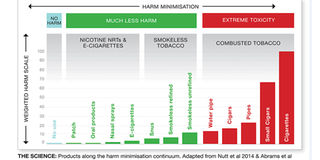We should not waste the opportunity to save smokers’ lives
Sponsored by Campaign for Safer Alternatives

By Joseph Magero
A remarkable 2.8 million Kenyans smoke. For many, quitting simply is not an option, with the majority who try to do so ultimately failing.
As a onetime smoker myself, I struggled to give up the habit for many years. Even though I knew the health risks and promised my friends and family that I’d quit, I found myself repeatedly being drawn back to cigarettes. It wasn’t until a friend gave me a vape that I was able to give up cigarettes once and for all. I’m proud to say that I’ve been smoke-free for almost 10 years now.
One in every two long-term smokers dies from a tobacco-related disease. It’s hard to know if I would have faced the same fate had I not been able to quit, but I firmly believe I owe my life to vaping.
It was my experience with vaping that led me to set up the Campaign for Safer Alternatives (CASA), through which I’m pursuing my mission to ensure smokers across Africa gain access to the best tools and policies available to help them quit.
There has been a lot of misinformation circulating in Kenya about the safety of vaping and nicotine pouches compared to cigarettes, and this has resulted in misguided proposals by our legislators.
Independent research by leading global organisations such as the Royal College of Physicians and Cochrane, has found that safer alternatives play an important role in reducing tobacco-related harm and helping smokers quit. In January, Cochrane published a major evidence review of 27,235 smokers, which concluded that those who use vapes are more than twice as likely to quit than the ones who rely solely on behavioural support.
Leading government health agencies around the world also recognise the role that vapes and nicotine pouches offer smokers a safer alternative to tobacco. The US Food and Drug Administration (FDA) has declared that nicotine pouches “will significantly reduce harm and the risk of tobacco-related disease to individual tobacco users and benefit the health of the population as a whole”.
Unfortunately, the findings of these respected public health organisations are being ignored by legislators in Kenya, and in some cases being directly contradicted.
The Ministry of Health is in the process of collecting submissions on its proposal to put graphic health warnings on nicotine pouches and vapes which claim that they’re not safer alternatives to smoking. These warnings are misleading as they do not reflect the scientific evidence that these products pose a much lower health risk than traditional tobacco products. More concerning, the warnings will have the confounding effect of deterring smokers from switching to alternatives that could save their lives.
The use of visually gruesome health warnings is typically associated with traditional cigarettes, which carry a much higher risk of harm due to the combustion of tobacco. Placing similar warnings on alternative nicotine products will create confusion and deter smokers from transitioning to these less harmful alternatives.
It is widely acknowledged that it’s the burning of tobacco that causes the fatal diseases associated with smoking, not the nicotine. In fact, the World Health Organisation (WHO) includes nicotine in its list of essential medicines in the form of nicotine replacement therapies like patches and gums. Meanwhile, the UK’s National Health Service (NHS) states: “Although nicotine is addictive, it is relatively harmless to health.”
Kenyan smokers also deserve to receive clear, unbiased and evidence-based messaging.
Let me be clear: Nicotine is dependency-forming, and no one should start using these products if they don’t smoke. However, as vapes and pouches pose a small fraction of the risks compared to smoking, any official messaging about them should convey this.
By acknowledging the significant difference in risk between cigarettes and vapes, health warnings can be tailored to reflect the reality. This does not mean downplaying the potential health effects of vapes, but rather providing a more nuanced picture.
Regulations should also reflect the need for strong policies to prevent uptake by the underage and ongoing research to monitor long term effects. However, there should be a more sophisticated approach to risk communication. Health warnings must be grounded in science and they should not deter smokers from switching to safer alternatives.
For this reason, CASA and the wider harm reduction community respectfully urges the Ministry of Health to reconsider its proposed graphic health warnings for alternative nicotine products.
In their current form, the warnings would not only be counter-productive to our efforts to improve public health, but could also undermine the potential benefits of harm reduction strategies for smokers in Kenya.
Spotlight on the science
In April, the Royal College of Physicians, which represents 40,000 physicians worldwide, published the report, E-cigarettes and Harm Reduction: An Evidence Review. The report stated that “vaping is still far less harmful than smoking tobacco” and that “reduced risk messages should be included on e-cigarette packs”.
Key outtakes from the report
- “E-cigarettes should be promoted as an effective means of helping people who smoke to quit smoking tobacco.”
- Vapes are “demonstrably less harmful than smoked tobacco to user and bystander alike”.
- “Countries that have banned vapes have left far more harmful combusted tobacco products on general sale.”
- “Evidence from randomised controlled trials and from two Cochrane reviews shows e-cigarettes with nicotine are more effective at helping people quit at six months or longer than nicotine replacement therapy (NRT).”
- “Vaping should be offered as an effective treatment for smoking cessation across all medical settings [in the UK] alongside established pharmacotherapy.”
- “Evidence suggests that providing information aimed at increasing accurate relative perceptions of vaping compared with smoking can be successful among adults.”
The nicotine risk continuum

There is a common misbelief that nicotine products are the same as cigarettes, despite the science saying otherwise.
The risk continuum (illustrated above) is a scientific method to identify the least harmful way for smokers to consume nicotine.
Nicotine pouches and e-cigarettes are considered low-risk and are comparable to nicotine replacement therapies such as gum and sprays on the continuum.
By comparison, products that burn tobacco are considered extremely toxic and are a far riskier and harmful way for smokers to consume nicotine.
If smokers can be convinced to move from tobacco products to tobacco-free nicotine products like patches, pouches or vapes, they can dramatically reduce their health risks.
In an ideal world, people would give up using nicotine completely but the reality is that many people struggle to do so. Therefore, moving them to less harmful products is a way to prevent smoking-related death and disease.
According to Cochrane, smokers who try vaping to quit are more likely to succeed than those who use traditional nicotine therapies.
It’s vital that the confusion around the safety of these products and their relative risks is addressed. Kenyan smokers’ lives hang in the balance.
The Swedish success story
Countries that have embraced safer alternatives and supported smokers to switch are seeing tremendous public health results.
Sweden, which once had 49 percent of its men smoking cigarettes, is about to become officially smoke-free.
The Swedes have employed similar education and tobacco control efforts to many other countries. But the big difference is that they have also embraced the role of a wide range of reduced-risk alternatives to traditional cigarettes and have created a policy environment which encourages smokers to switch.
They have worked to make safer alternative products more accessible, more acceptable and more affordable than cigarettes.
For example, Sweden doesn’t have graphic health warnings, instead opting for evidence-based text health warnings which focus on the fact that nicotine is addictive. The Swedish government also recently reduced the tax on nicotine pouches and dismissed proposals to restrict vape flavours in recognition of the role they are playing in helping smokers quit.
Sweden’s tobacco-control policies and approach to alternatives have seen the number of smokers drop at its fastest rate ever – driven by the recent introduction of vapes and nicotine pouches.
As a result, today Sweden has the lowest levels of tobacco-related deaths and disease of any EU country. In fact, tobacco-related deaths in Sweden are 44 percent lower than the EU average.
What Kenyan users of alternative nicotine products say...
“I have been able to drop cigarettes completely because of nicotine pouches.” A. Leyian
“I have been able to cut down from 14 cigarettes to two or none, thanks to nicotine pouches.” M. Kamaita
“Having had trouble cycling or working out due to chest problems, nicotine pouches for me have been the best remedy. From almost one pack (of cigarettes) daily to now using two cans of pouches a week has greatly improved my health.” N. Dima
“Since the pouches don’t hurt my chest and there is no smoke, I prefer them over cigarettes and intend to use them to stay smoke-free. It has been working so far.” Anonymous
“I have stayed away from smoking with the help of nicotine pouches. For me, they are not as harmful as what I was smoking.” D. Sanda
“In the past, I have tried almost all methods, including hypnosis. E-cigarettes have been the only thing that has worked to this day.” A.Nyokabi
_______________
Joseph Magero is the Chairman of Campaign for Safer Alternatives (CASA)

About CASA
Campaign forSafer Alternatives (CASA) is an international Pan-African non-governmental organisation dedicated to achieving 100 percent smoke-free environments in Africa. We are the unifying voice for consumer organisations advocating for tobacco harm reduction in Africa, promoting discussion and the exchange of information and potential actions to reduce exposure to tobacco-related harm. For more information about us, go to https://safer-alternatives.org
For a downloadable PDF version of this article, click here.


